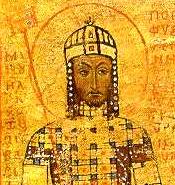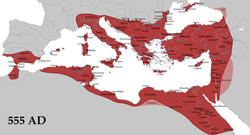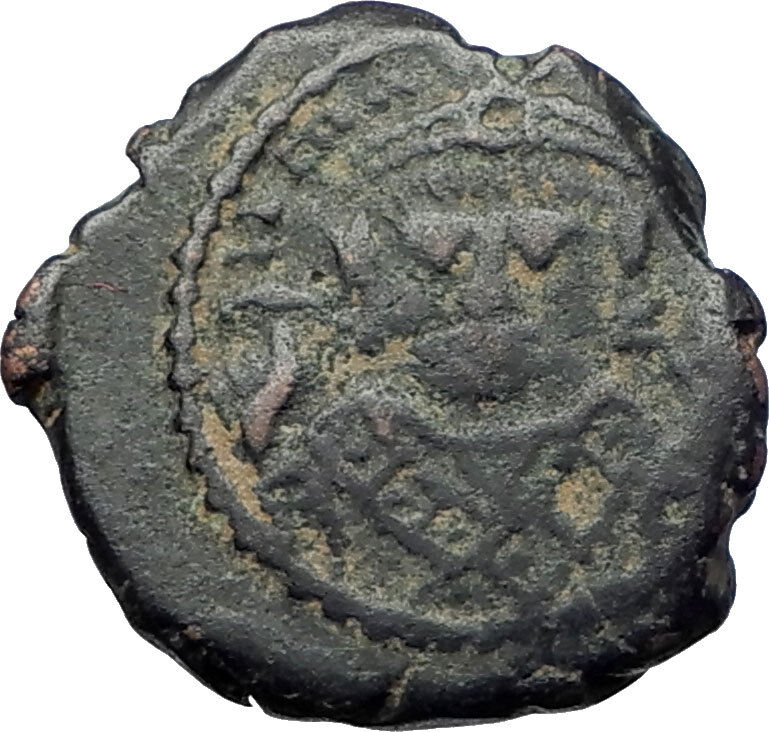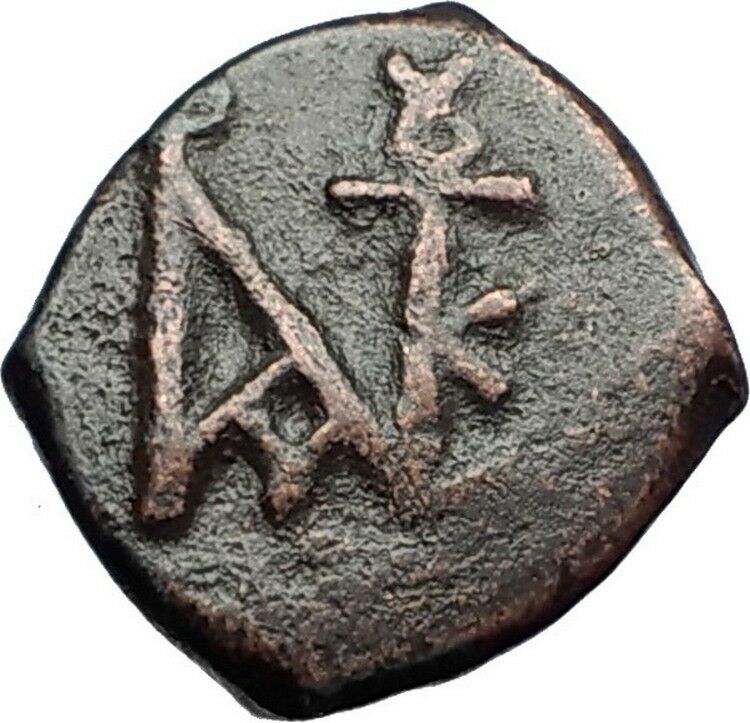|
Byzantine Empire
Manuel I, Comnenus – Byzantine Emperor: 8 April 1143 – 24 September 1180 A.D.
Bronze Tetarteron 16mm (3.15 grams) Thessalonica mint, struck circa 1143-1180 A.D.
Reference: Sear 1968
MP – ΘV, Virgin Mary, mother of Jesus Christ, nimbate, standing right, hands raised towards hand of God at upper right.
MANYHΛ ΔECΠOTHC, Manuel standing facing, crowned, wearing divitision and loros and holding cross-tipped sceptre and akakia.
You are bidding on the exact item pictured, provided with a Certificate of Authenticity and Lifetime Guarantee of Authenticity.
 Mary (Hebrew: מִרְיָם, Miriam; Aramaic: Maryām; Arabic: مريم, Maryam), variously called Saint Mary, Mother Mary, the Virgin Mary, the Theotokos, the Blessed Virgin Mary, Mary, Mother of God, and, in Islam, as Maryam, mother of Isa’, was an Israelite Jewish woman of Nazareth in Galilee who lived in the late 1st century BC and early 1st century AD, and is considered by Christians to be the first proselyte to Christianity. She is identified in the New Testament[Mt 1:16,18-25][Lk 1:26-56][2:1-7] and in the Qur’an as the mother of Jesus through divine intervention. Christians hold her son Jesus to be Christ (i.e. the messiah) and God the Son Incarnate (see Trinitarian monotheism), whereas Muslims regard Jesus as the messiah and the most important prophet of God sent to the people of Israel (and the second-most-important prophet of all, lesser than Muhammad alone). Mary (Hebrew: מִרְיָם, Miriam; Aramaic: Maryām; Arabic: مريم, Maryam), variously called Saint Mary, Mother Mary, the Virgin Mary, the Theotokos, the Blessed Virgin Mary, Mary, Mother of God, and, in Islam, as Maryam, mother of Isa’, was an Israelite Jewish woman of Nazareth in Galilee who lived in the late 1st century BC and early 1st century AD, and is considered by Christians to be the first proselyte to Christianity. She is identified in the New Testament[Mt 1:16,18-25][Lk 1:26-56][2:1-7] and in the Qur’an as the mother of Jesus through divine intervention. Christians hold her son Jesus to be Christ (i.e. the messiah) and God the Son Incarnate (see Trinitarian monotheism), whereas Muslims regard Jesus as the messiah and the most important prophet of God sent to the people of Israel (and the second-most-important prophet of all, lesser than Muhammad alone).
 The canonical gospels of Matthew and Luke describe Mary as a virgin (Greek παρθένος, parthénos). Traditionally, Christians believe that she conceived her son miraculously by the agency of the Holy Spirit. Muslims believe that she conceived by the command of God. This took place when she was already betrothed to Saint Joseph and was awaiting the concluding rite of marriage, the formal home-taking ceremony. She married Joseph and accompanied him to Bethlehem, where Jesus was born. In keeping with Jewish custom, the betrothal would have taken place when she was around 12, and the birth of Jesus about a year later. The canonical gospels of Matthew and Luke describe Mary as a virgin (Greek παρθένος, parthénos). Traditionally, Christians believe that she conceived her son miraculously by the agency of the Holy Spirit. Muslims believe that she conceived by the command of God. This took place when she was already betrothed to Saint Joseph and was awaiting the concluding rite of marriage, the formal home-taking ceremony. She married Joseph and accompanied him to Bethlehem, where Jesus was born. In keeping with Jewish custom, the betrothal would have taken place when she was around 12, and the birth of Jesus about a year later.
The New Testament begins its account of Mary’s life with the Annunciation, when the angel Gabriel appeared to her and announced her divine selection to be the mother of Jesus. Church tradition and early non-biblical writings state that her parents were an elderly couple, Saint Joachim and Saint Anne. The Bible records Mary’s role in key events of the life of Jesus from his conception to his Ascension. Apocryphal writings tell of her subsequent death and bodily assumption into heaven.
Christians of the Catholic Church, the Eastern Orthodox Church, Oriental Orthodox Church, Anglican Communion, and Lutheran churches believe that Mary, as mother of Jesus, is the Mother of God (Μήτηρ Θεοῦ) and the Theotokos, literally Bearer of God. Mary has been venerated since Early Christianity. Throughout the ages she has been a favorite subject in Christian art, music, and literature.
There is significant diversity in the Marian beliefs and devotional practices of major Christian traditions. The Catholic Church has a number of Marian dogmas, such as the Immaculate Conception of Mary the Perpetual Virginity of Mary, and the Assumption of Mary into Heaven. Catholics refer to her as Our Lady and venerate her as the Queen of Heaven and Mother of the Church; most Protestants do not share these beliefs. Many Protestants see a minimal role for Mary within Christianity, based on the brevity of biblical references.
Manuel I Komnenos, or Comnenus (Greek: Μανουήλ Α’ Κομνηνός, Manouēl I Komnēnos, November 28, 1118 – September 24, 1180) was a Byzantine Emperor  of the 12th century who reigned over a crucial turning point in the history of Byzantium and the Mediterranean. Eager to restore his empire to its past glories as the superpower of the Mediterranean world, Manuel pursued an energetic and ambitious foreign policy. In the process he made alliances with the Pope and the resurgent west, invaded Italy, successfully handled the passage of the dangerous Second Crusade through his empire, and established a Byzantine protectorate over the Crusader kingdoms of Outremer. Facing Muslim advances in the Holy Land, he made common cause with the Kingdom of Jerusalem and participated in a combined invasion of Fatimid Egypt. Manuel reshaped the political maps of the Balkans and the east Mediterranean, placing the kingdoms of Hungary and Outremer under Byzantine hegemony and campaigning aggressively against his neighbours both in the west and in the east. However, towards the end of his reign Manuel’s achievements in the east were compromised by a serious defeat at Myriokephalon, which in large part resulted from his arrogance in attacking a well-defended Seljuk position. of the 12th century who reigned over a crucial turning point in the history of Byzantium and the Mediterranean. Eager to restore his empire to its past glories as the superpower of the Mediterranean world, Manuel pursued an energetic and ambitious foreign policy. In the process he made alliances with the Pope and the resurgent west, invaded Italy, successfully handled the passage of the dangerous Second Crusade through his empire, and established a Byzantine protectorate over the Crusader kingdoms of Outremer. Facing Muslim advances in the Holy Land, he made common cause with the Kingdom of Jerusalem and participated in a combined invasion of Fatimid Egypt. Manuel reshaped the political maps of the Balkans and the east Mediterranean, placing the kingdoms of Hungary and Outremer under Byzantine hegemony and campaigning aggressively against his neighbours both in the west and in the east. However, towards the end of his reign Manuel’s achievements in the east were compromised by a serious defeat at Myriokephalon, which in large part resulted from his arrogance in attacking a well-defended Seljuk position.
Called ho Megas (Greek: ὁ Μέγας, translated as “the Great”) by the Greeks, Manuel is known to have inspired intense loyalty in those who served him. He also appears as the hero of a history written by his secretary, John Kinnamos, in which every virtue is attributed to him. Manuel, who was influenced by his contact with western Crusaders, enjoyed the reputation of “the most blessed emperor of Constantinople” in parts of the Latin world as well. Modern historians, however, have been less enthusiastic about him. Some of them assert that the great power he wielded was not his own personal achievement, but that of the dynasty he represented; they also argue that, since Byzantine imperial power declined so rapidly after Manuel’s death, it is only natural to look for the causes of this decline in his reign.
 The Byzantine Empire, or Eastern Roman Empire, was the predominantly Greek-speaking eastern half continuation and remainder of the Roman Empire during Late Antiquity and the Middle Ages. Its capital city was Constantinople (modern-day Istanbul), originally founded as Byzantium. It survived the fragmentation and fall of the Western Roman Empire in the 5th century AD and continued to exist for an additional thousand years until it fell to the Ottoman Turks in 1453. During most of its existence, the empire was the most powerful economic, cultural, and military force in Europe. Both “Byzantine Empire” and “Eastern Roman Empire” are historiographical terms created after the end of the realm; its citizens continued to refer to their empire as the Roman Empire (Ancient Greek: Βασιλεία Ῥωμαίων, tr. Basileia Rhōmaiōn; Latin: Imperium Romanum), or Romania (Ῥωμανία), and to themselves as “Romans”. The Byzantine Empire, or Eastern Roman Empire, was the predominantly Greek-speaking eastern half continuation and remainder of the Roman Empire during Late Antiquity and the Middle Ages. Its capital city was Constantinople (modern-day Istanbul), originally founded as Byzantium. It survived the fragmentation and fall of the Western Roman Empire in the 5th century AD and continued to exist for an additional thousand years until it fell to the Ottoman Turks in 1453. During most of its existence, the empire was the most powerful economic, cultural, and military force in Europe. Both “Byzantine Empire” and “Eastern Roman Empire” are historiographical terms created after the end of the realm; its citizens continued to refer to their empire as the Roman Empire (Ancient Greek: Βασιλεία Ῥωμαίων, tr. Basileia Rhōmaiōn; Latin: Imperium Romanum), or Romania (Ῥωμανία), and to themselves as “Romans”.
Several events from the 4th to 6th centuries mark the transitional period during which the Roman Empire’s east and west divided. In 285, the emperor Diocletian (r. 284-305) partitioned the Roman Empire’s administration into eastern and western halves. Between 324 and 330, Constantine I (r. 306-337) transferred the main capital from Rome to Byzantium, later known as Constantinople (“City of Constantine”) and Nova Roma (“New Rome”). Under Theodosius I (r. 379-395), Christianity became the Empire’s official state religion and others such as Roman polytheism were proscribed. And finally, under the reign of Heraclius (r. 610-641), the Empire’s military and administration were restructured and adopted Greek for official use instead of Latin. Thus, although it continued the Roman state and maintained Roman state traditions, modern historians distinguish Byzantium from ancient Rome insofar as it was oriented towards Greek rather than Latin culture, and characterised by Orthodox Christianity rather than Roman polytheism.
The borders of the Empire evolved significantly over its existence, as it went through several cycles of decline and recovery. During the reign of Justinian I (r. 527-565), the Empire reached its greatest extent after reconquering much of the historically Roman western Mediterranean coast, including north Africa, Italy, and Rome itself, which it held for two more centuries. During the reign of Maurice (r. 582-602), the Empire’s eastern frontier was expanded and the north stabilised. However, his assassination caused a two-decade-long war with Sassanid Persia which exhausted the Empire’s resources and contributed to major territorial losses during the Muslim conquests of the 7th century. In a matter of years the Empire lost its richest provinces, Egypt and Syria, to the Arabs.
During the Macedonian dynasty (10th-11th centuries), the Empire again expanded and experienced a two-century long renaissance, which came to an end with the loss of much of Asia Minor to the Seljuk Turks after the Battle of Manzikert in 1071. This battle opened the way for the Turks to settle in Anatolia as a homeland.
The final centuries of the Empire exhibited a general trend of decline. It struggled to recover during the 12th century, but was delivered a mortal blow during the Fourth Crusade, when Constantinople was sacked and the Empire dissolved and divided into competing Byzantine Greek and Latin realms. Despite the eventual recovery of Constantinople and re-establishment of the Empire in 1261, Byzantium remained only one of several small rival states in the area for the final two centuries of its existence. Its remaining territories were progressively annexed by the Ottomans over the 15th century. The Fall of Constantinople to the Ottoman Empire in 1453 finally ended the Byzantine Empire.
|





 Mary (Hebrew: מִרְיָם, Miriam; Aramaic: Maryām; Arabic: مريم, Maryam), variously called Saint Mary, Mother Mary, the Virgin Mary, the Theotokos, the Blessed Virgin Mary, Mary, Mother of God, and, in Islam, as Maryam, mother of Isa’, was an Israelite Jewish woman of Nazareth in Galilee who lived in the late 1st century BC and early 1st century AD, and is considered by Christians to be the first proselyte to Christianity. She is identified in the New Testament[Mt 1:16,18-25][Lk 1:26-56][2:1-7] and in the Qur’an as the mother of Jesus through divine intervention. Christians hold her son Jesus to be Christ (i.e. the messiah) and God the Son Incarnate (see Trinitarian monotheism), whereas Muslims regard Jesus as the messiah and the most important prophet of God sent to the people of Israel (and the second-most-important prophet of all, lesser than Muhammad alone).
Mary (Hebrew: מִרְיָם, Miriam; Aramaic: Maryām; Arabic: مريم, Maryam), variously called Saint Mary, Mother Mary, the Virgin Mary, the Theotokos, the Blessed Virgin Mary, Mary, Mother of God, and, in Islam, as Maryam, mother of Isa’, was an Israelite Jewish woman of Nazareth in Galilee who lived in the late 1st century BC and early 1st century AD, and is considered by Christians to be the first proselyte to Christianity. She is identified in the New Testament[Mt 1:16,18-25][Lk 1:26-56][2:1-7] and in the Qur’an as the mother of Jesus through divine intervention. Christians hold her son Jesus to be Christ (i.e. the messiah) and God the Son Incarnate (see Trinitarian monotheism), whereas Muslims regard Jesus as the messiah and the most important prophet of God sent to the people of Israel (and the second-most-important prophet of all, lesser than Muhammad alone). The canonical gospels of Matthew and Luke describe Mary as a virgin (Greek παρθένος, parthénos). Traditionally, Christians believe that she conceived her son miraculously by the agency of the Holy Spirit. Muslims believe that she conceived by the command of God. This took place when she was already betrothed to Saint Joseph and was awaiting the concluding rite of marriage, the formal home-taking ceremony. She married Joseph and accompanied him to Bethlehem, where Jesus was born. In keeping with Jewish custom, the betrothal would have taken place when she was around 12, and the birth of Jesus about a year later.
The canonical gospels of Matthew and Luke describe Mary as a virgin (Greek παρθένος, parthénos). Traditionally, Christians believe that she conceived her son miraculously by the agency of the Holy Spirit. Muslims believe that she conceived by the command of God. This took place when she was already betrothed to Saint Joseph and was awaiting the concluding rite of marriage, the formal home-taking ceremony. She married Joseph and accompanied him to Bethlehem, where Jesus was born. In keeping with Jewish custom, the betrothal would have taken place when she was around 12, and the birth of Jesus about a year later. of the 12th century who reigned over a crucial turning point in the history of Byzantium and the Mediterranean. Eager to restore his empire to its past glories as the superpower of the Mediterranean world, Manuel pursued an energetic and ambitious foreign policy. In the process he made alliances with the Pope and the resurgent west, invaded Italy, successfully handled the passage of the dangerous Second Crusade through his empire, and established a Byzantine protectorate over the Crusader kingdoms of Outremer. Facing Muslim advances in the Holy Land, he made common cause with the Kingdom of Jerusalem and participated in a combined invasion of Fatimid Egypt. Manuel reshaped the political maps of the Balkans and the east Mediterranean, placing the kingdoms of Hungary and Outremer under Byzantine hegemony and campaigning aggressively against his neighbours both in the west and in the east. However, towards the end of his reign Manuel’s achievements in the east were compromised by a serious defeat at Myriokephalon, which in large part resulted from his arrogance in attacking a well-defended Seljuk position.
of the 12th century who reigned over a crucial turning point in the history of Byzantium and the Mediterranean. Eager to restore his empire to its past glories as the superpower of the Mediterranean world, Manuel pursued an energetic and ambitious foreign policy. In the process he made alliances with the Pope and the resurgent west, invaded Italy, successfully handled the passage of the dangerous Second Crusade through his empire, and established a Byzantine protectorate over the Crusader kingdoms of Outremer. Facing Muslim advances in the Holy Land, he made common cause with the Kingdom of Jerusalem and participated in a combined invasion of Fatimid Egypt. Manuel reshaped the political maps of the Balkans and the east Mediterranean, placing the kingdoms of Hungary and Outremer under Byzantine hegemony and campaigning aggressively against his neighbours both in the west and in the east. However, towards the end of his reign Manuel’s achievements in the east were compromised by a serious defeat at Myriokephalon, which in large part resulted from his arrogance in attacking a well-defended Seljuk position. The Byzantine Empire, or Eastern Roman Empire, was the predominantly Greek-speaking eastern half continuation and remainder of the Roman Empire during Late Antiquity and the Middle Ages. Its capital city was Constantinople (modern-day Istanbul), originally founded as Byzantium. It survived the fragmentation and fall of the Western Roman Empire in the 5th century AD and continued to exist for an additional thousand years until it fell to the Ottoman Turks in 1453. During most of its existence, the empire was the most powerful economic, cultural, and military force in Europe. Both “Byzantine Empire” and “Eastern Roman Empire” are historiographical terms created after the end of the realm; its citizens continued to refer to their empire as the Roman Empire (Ancient Greek: Βασιλεία Ῥωμαίων, tr. Basileia Rhōmaiōn; Latin: Imperium Romanum), or Romania (Ῥωμανία), and to themselves as “Romans”.
The Byzantine Empire, or Eastern Roman Empire, was the predominantly Greek-speaking eastern half continuation and remainder of the Roman Empire during Late Antiquity and the Middle Ages. Its capital city was Constantinople (modern-day Istanbul), originally founded as Byzantium. It survived the fragmentation and fall of the Western Roman Empire in the 5th century AD and continued to exist for an additional thousand years until it fell to the Ottoman Turks in 1453. During most of its existence, the empire was the most powerful economic, cultural, and military force in Europe. Both “Byzantine Empire” and “Eastern Roman Empire” are historiographical terms created after the end of the realm; its citizens continued to refer to their empire as the Roman Empire (Ancient Greek: Βασιλεία Ῥωμαίων, tr. Basileia Rhōmaiōn; Latin: Imperium Romanum), or Romania (Ῥωμανία), and to themselves as “Romans”.




